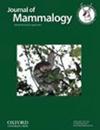金芒地松鼠(Callospermophilus lateralis)的散布情况
IF 1.6
3区 生物学
Q2 ZOOLOGY
引用次数: 0
摘要
散居在哺乳动物中很常见,在形成种群、遗传、分布和社会结构方面起着重要作用。散布会带来潜在的成本和潜在的收益,散布决定被认为是有条件的;潜在的散布者会评估其在当前地点的成功前景,并散布以提高其适应能力。然而,人们对散布的成本和收益以及影响散布决定的因素知之甚少。我们利用诱捕和观察方法研究了金绒毛地松鼠(Callospermophilus lateralis)的扩散情况。我们通过评估散布时间和距离来描述散布过程,评估可能影响散布决定的因素,并分析定居后散布的适应成本。我们发现,大多数松鼠都是在出生后的夏季进行扩散的,这也符合小体型箭猪的预期。不过,有些松鼠会推迟到一岁的初夏才散居。松鼠的扩散倾向是雄性偏向的,扩散距离也是雄性偏向的,但扩散距离较短。幼年雌性的驱散决定似乎是在它们离开产地洞穴10天后做出的,而且这种决定与体重或几种竞争措施无关。相反,幼年雌性的扩散与同窝姐妹的数量有关,每出现一个姐妹,扩散的可能性就增加26%。同窝姐妹可能是预示来年亲属竞争影响的线索。我们没有发现定居后的集群雌鼠和散居雌鼠的终生繁殖成功率有显著差异,这表明对于金芒刺地松鼠来说,散居的任何代价都主要是在过渡阶段经历的。本文章由计算机程序翻译,如有差异,请以英文原文为准。
Dispersal of the Golden-mantled Ground Squirrel (Callospermophilus lateralis)
Dispersal is common in mammals and can have an important role in shaping demography, genetics, distribution, and social structure. Dispersal entails potential costs but also potential benefits, and the dispersal decision is thought to be conditional; the potential disperser assesses prospects for success at its current location and disperses to improve its fitness. However, the costs and benefits of dispersal, as well as factors influencing the dispersal decision, are not well known. We used trapping and observation to study dispersal in the Golden-mantled Ground Squirrel (Callospermophilus lateralis), a species for which dispersal is largely unknown. We characterized the dispersal process by evaluating dispersal timing and distance, assessed factors that might influence the dispersal decision, and analyzed the fitness cost of dispersal after settlement. We found that most dispersal occurred during the summer of birth, as is expected for a small-bodied sciurid. However, some squirrels delayed dispersal until early in their yearling summer. Dispersal was male-biased in dispersal tendency, and it was also male-biased in dispersal distance, but only over shorter dispersal distances. The dispersal decision for juvenile females appeared to originate as soon as 10 days after they emerged from the natal burrow, and the decision was not associated with body mass or several measures of competition. Instead, dispersal of juvenile females was associated with the number of littermate sisters, with each sister present increasing the likelihood of dispersal by 26%. Littermate sisters might be a cue foretelling the effects of kin competition the following year. We did not find a significant difference in lifetime reproductive success between philopatric and dispersing females after settlement, suggesting that for golden-mantled ground squirrels, any cost of dispersal is experienced primarily during the transience phase.
求助全文
通过发布文献求助,成功后即可免费获取论文全文。
去求助
来源期刊

Journal of Mammalogy
生物-动物学
CiteScore
3.30
自引率
5.90%
发文量
106
审稿时长
4-8 weeks
期刊介绍:
Papers are published on mammalian behavior, conservation, ecology, genetics, morphology, physiology, and taxonomy.
 求助内容:
求助内容: 应助结果提醒方式:
应助结果提醒方式:


